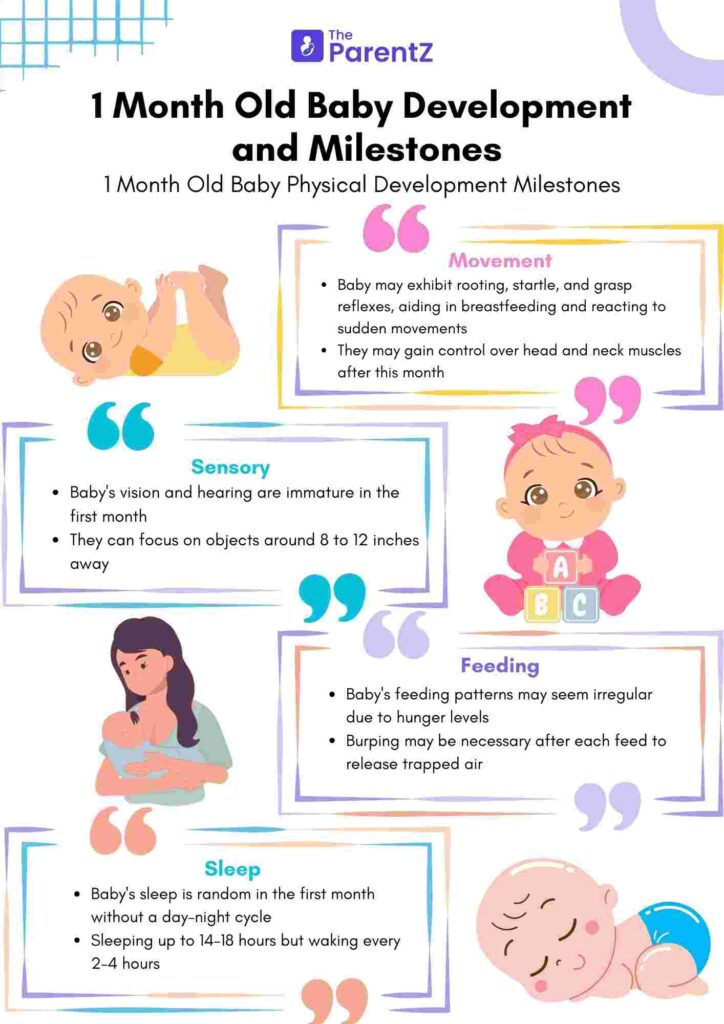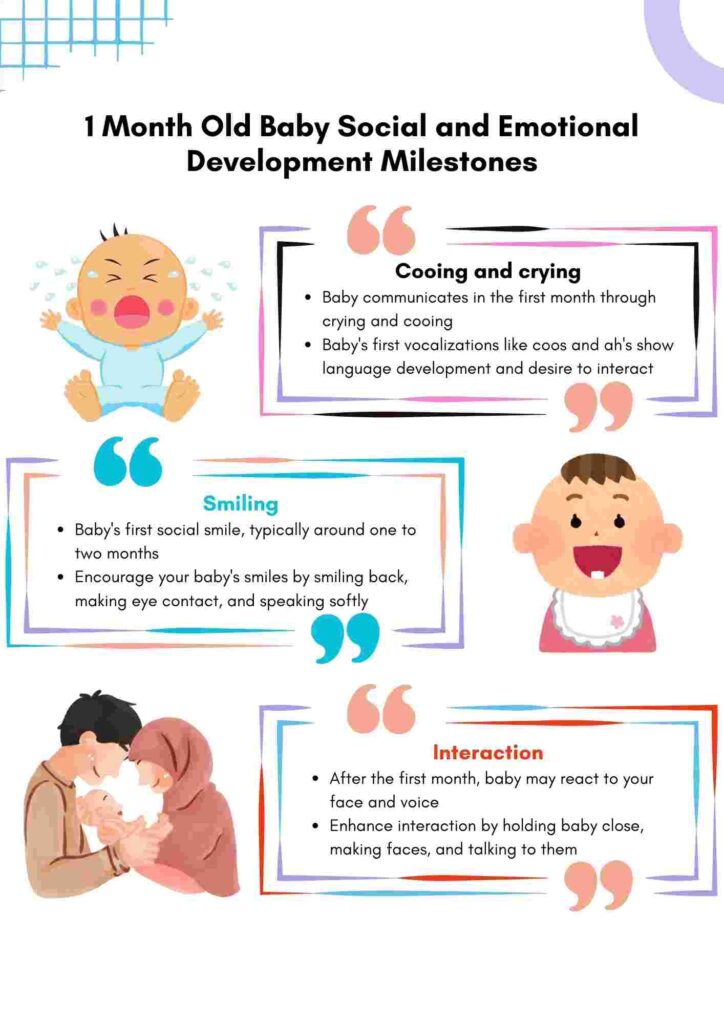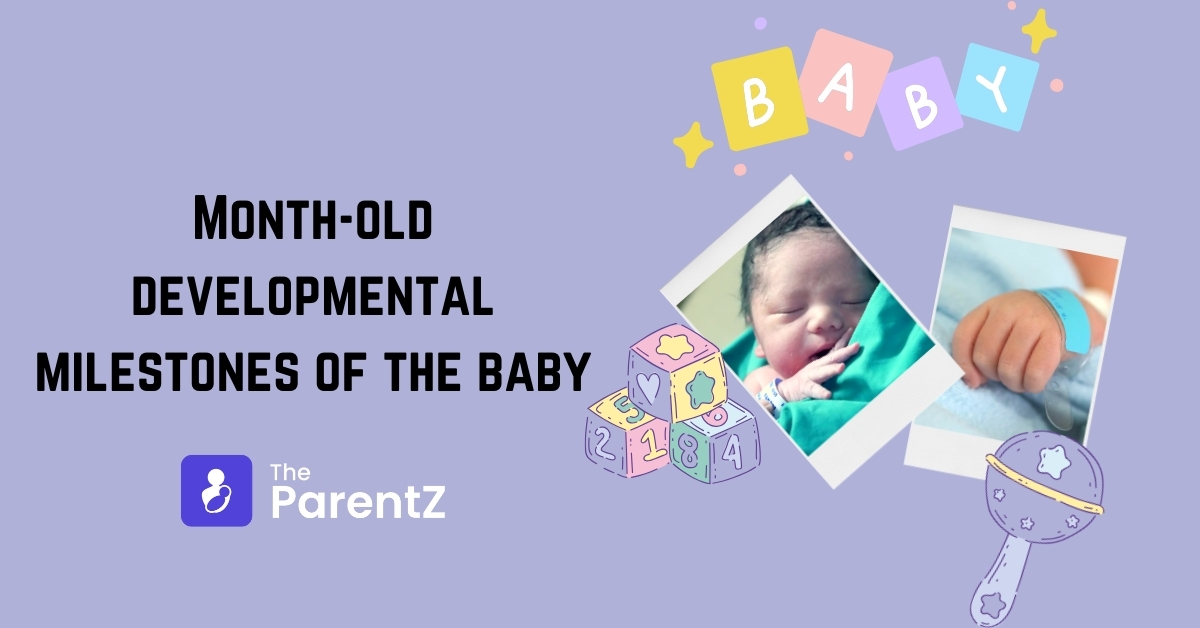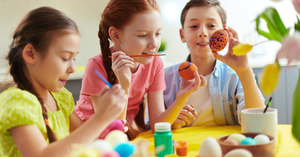The first month of life is one lovely revealing era as your baby passes through rapid and magical changes that take his shape, make him sense, respond to sounds, and face real-tense situations but come out perfect. They grow and develop every day, reaching various milestones that pave the way for future skills. In this article, we are going to discuss some of the developmental milestones that your baby can achieve in their first month and how you should support them.
Here are some of the growth and developmental milestones your 1-month-old may reach:
1 Month Old Baby Physical Development Milestones
The first month of your baby’s life is an amazing and exciting time, as they undergo rapid and remarkable changes in their physical, sensory, and social development. Your baby is learning and growing every day, and achieving many milestones that will lay the foundation for their future skills and abilities. In this article, we will explore some of the key developmental milestones that your baby may reach in their first month, and how you can support and nurture their development.
Movement
The baby may exhibit the rooting reflex, the morpho/startle response, and the grasp reflex. Rooting is a conscious suckling behaviour that helps the infant orient towards your breast or bottle, while the latter is referred to as “fallen leave” behaviour since it makes him start with surprise about some sudden changes in movement or position along with spreading his arms and legs.
Your baby may also start to gain some control over their head and neck muscles, and may be able to lift their head slightly when lying on their stomach or turn their head from side to side when lying on their back.
Sensory
In the first month of their life, your baby’s vision and hearing are immature, for he or she can see or hear very poorly both close-up and far.
On the other hand, during this period, your baby can capture objects such as a toy or even your face that are around 8 to 12 inches away from his or her eyes, and he may trace them when slowly approaching in the moving direction of his or her vision field.
Signs that the baby has developed hearing include responses to sounds; this can be your voice or a rattle, and sometimes he will turn his head or even his eyes towards it.
Feeding
In terms of how often your baby needs to feed, their feeding patterns may seem irregular due to differences in hunger levels, growth and sleep being factored in. The feeding frequency may range from two feeds every four hours, and your baby would take about 2 to 4 ounces of breast milk or formula with each feed.
Your baby may also have to be burped after each feed because they tend to suck in some air once taking their milk. Infant burping may be facilitated by carefully rubbing or patting his or her back and holding him up on your shoulder or our lap.
Sleep
Your baby’s sleep pattern is likely to be random and unpredictable in the first month because he has yet to create a circadian rhythm or day-night cycle. Your baby will sleep up to 14–18 hours a day; however, they probably won’t stay asleep for more than two or four hours at a time.
The sleep pattern of your baby is not limited to just 2 stages; there are phases like non-REM (light sleep), REM (deep sleep), and Rapid Eye Movement (memory recall stage).
These three types play a vital role in developing the brain as well as becoming the mediums for referring. Offer your child a comfortable yet safe sleeping environment by putting him or her on a firm flat mattress, a fitted sheet, and a light blanket (including a swaddle), all while avoiding pillows, bumpers, or stuffed animals. You may also make it easier for your child to differentiate between day and night by allowing exposure to natural light on the items during the day while ensuring that the room is darkened until they can sleep.
1 Month Old Baby Social and Emotional Development Milestones
Your baby’s social and emotional development in the first month is largely dependent on interactions with you; other people caring for him or her usually form secure attachments and trust. Some of the social and emotional milestones that your baby may achieve in the first month include:
Cooing and crying
How your infant usually bridges the communication gap in his or her first month is by crying and cooing. Your baby may cry for several reasons, such as hunger pangs or because he is uncomfortable or in pain, tiredness or boredom; and this will all be expressed in his distinctive sorts of cries, namely hungry ones and wet ones.
By observing your baby’s cues, their facial expressions, body movements, and sounds, you will learn to recognize the meaning of each cry as expressed in this sentence.
Your baby will probably also generate some first vocalizations, like coos or ah’s, etc., which mean that s/he is developing language and attempting to interact with a person. When you talk, sing, or read with your little one, you may symmetrize their sounds and expressions; therefore, encourage cooing.
Smiling
After a month or two, you might be amazed when your baby first flashes her or his social smile—an indication of the emotional process’s development and parent recognition. When your newborn sees, hears, or even feels you close by with a touch, the smile on his face reflects this feeling, and it makes him feel calm.
The smile of your newborn is one of the best mechanisms for linking you with the baby and letting it be happy. In order to elicit your child’s smile, you need to smile at him or her, make eye contact, and speak in a soft voice.
Interaction
Your baby may react to your face and voice after the first month; he or she might, for example, show social development as well as a reaction towards you. The infant may look at your face, mostly looking into your eyes and mouth, which can even try to imitate your facial expressions and movements.
The voice of your baby might be heard, which may include them turning their head or eyes towards you when talking. You can enhance your baby’s interaction by holding them close, making faces, and talking to them, and by responding to their cues and signals.
Conclusion
Overall, in the first month of your baby’s life, you witness a great variety of events that represent their physical growth and development as well as their sensory-motor perception maturation along with their emergence into the social world. No matter how it seems, your baby learns and grows each day. You can provide an environment stimulating for child development by cultivating love in them during their childhood.
For insights into your 2-month-old’s development, explore our article on 2 Month Old Development Milestone.


For you, the first month of your baby is not less significant or a painstaking period but replete with fun and pleasure, as this experience allows you to put love into action. Smiles from your child make one proud; such things as coos are counted among impressive vocal vehicles whose sweep captures human attention entirely. Even cuddles symbolize pure love that cannot be calculated racially.








Be the first one to comment on this story.